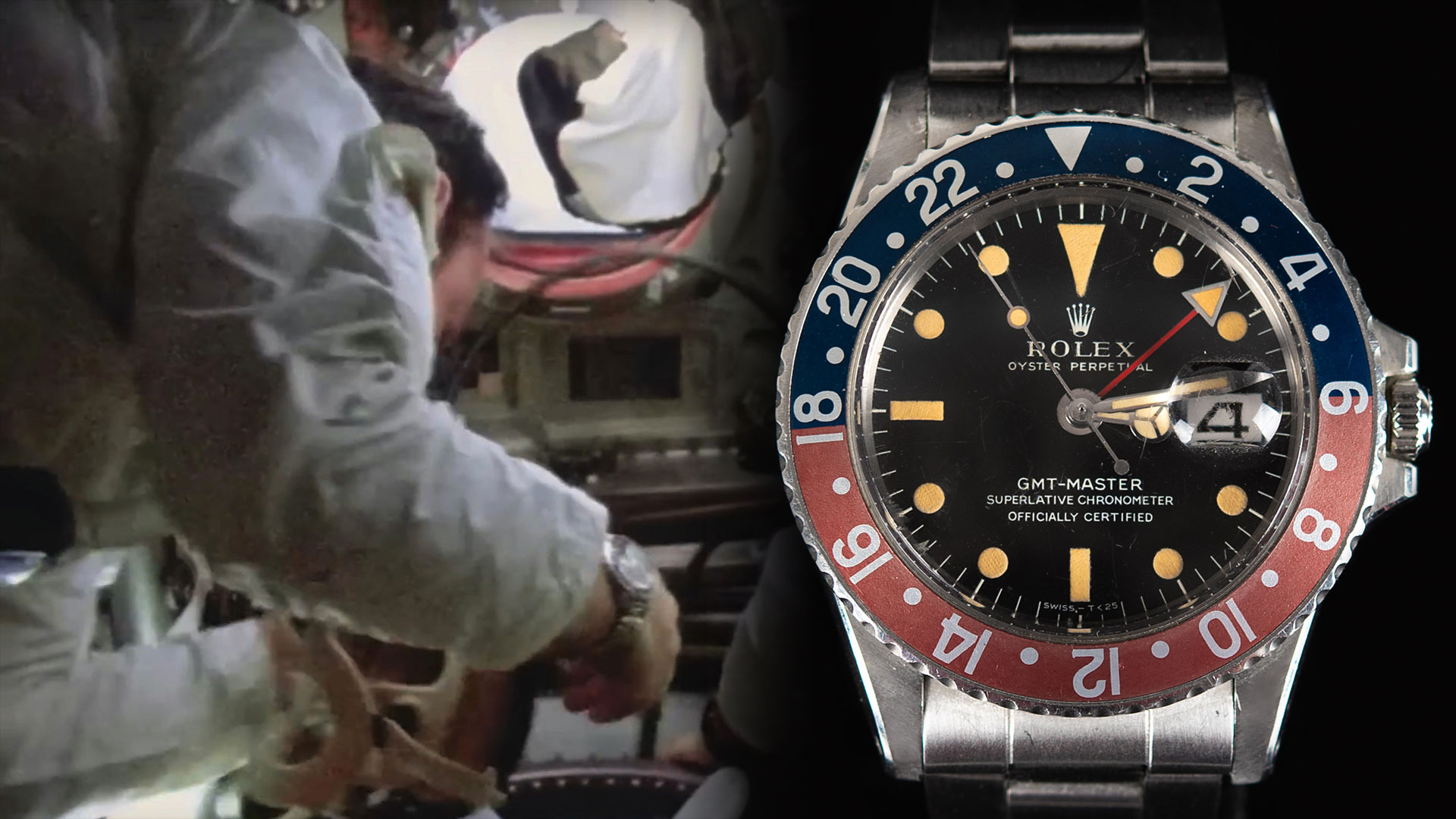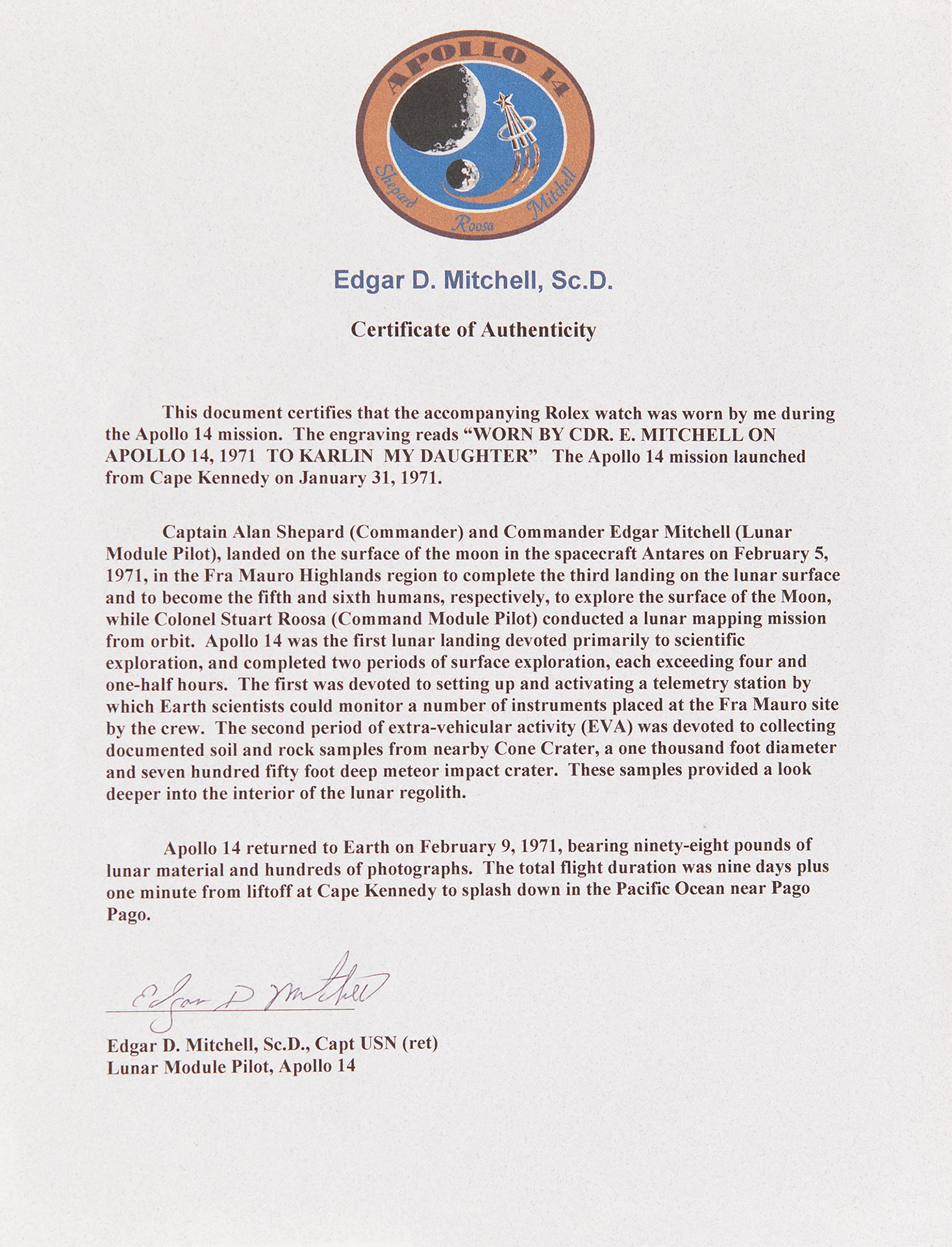Apollo 14 astronaut's personal moon-flown Rolex watch sells for record $2.2 million
'Watch collectors appreciate the importance of reliable timepieces that were used on historic lunar missions.'

A Rolex watch that was flown to the moon is now the most expensive astronaut timepiece to sell at auction.
The personal GMT-Master chronometer worn by NASA astronaut Edgar Mitchell as lunar module pilot on the 1971 Apollo 14 mission sold for $2.2 million (or to be precise, $2,163,199) on Thursday (Oct. 24). The watch attracted more than 30 bids during the course of RR Auction's latest space-themed sale, which ran from Sept. 26 on the New Hampshire firm's website.
The hammer price (prior to the buyer's premium) that clinched the moon-flown Rolex — one of only two that are known to have been sold — was $1,730,559. Before the sale began, RR Auction estimated the watch would fetch more than $400,000.
"We are thrilled with the result, because Ed Mitchell's Apollo Rolex is the most expensive item we've ever sold," Bobby Livingston, RR Auction's executive vice president for public relations, told collectSPACE.com soon after the auction ended. RR previously auctioned the first seat on Blue Origin's New Shepard rocket for $28 million, but Mitchell's Rolex was the most expensive physical item the company has sold since its founding in 1976.
"There is a huge crossover appeal to watch collectors who don't necessarily collect space material," said Livingston. "Watch collectors appreciate the importance of reliable timepieces that were used on historic lunar missions."
NASA issued each of its Apollo crew members with an Omega Speedmaster Professional chronograph to be used in space. The "Speedys" were government property and today are in the care of the Smithsonian.
Related: The Apollo Program: How NASA sent astronauts to the moon
Some Apollo astronauts chose to bring a second watch. Mostly hidden from view, as only the Omega watches were authorized to be worn on Velcro straps atop the astronauts' spacesuits, these personal timepieces were largely unknown to the public.
Eagle-eyed collectors and enthusiasts "discovered" the existence of these secondary watches by scouring the pre-launch, in-flight and post-landing imagery that was taken of the astronauts. Mitchell's Rolex can be seen in photos and film stills of him suiting up for his Jan. 31, 1971 launch and while aboard the Apollo 14 command module. Similarly, Apollo 13 crew member Jack Swigert and Apollo 17 astronaut Ron Evans are also known to have flown personal Rolex GMT-Masters.
Evans' Rolex, which remained with him in lunar orbit while his crewmates Gene Cernan and Harrison Schmitt landed on the moon, was sold by Dallas-based Heritage Auctions in 2009 for $131,450 (including the buyer's premium). Evans also came back from the moon with a Speedmaster he retained from a science experiment as a memento. Forty-three years later, Christie's auctioned Evans' Omega keepsake for $245,000. The Swiss watchmaker obtained the rare flown watch for its own museum in Bienne.
That same year (2015), RR Auction sold the only non-Omega watch to be worn over an Apollo astronaut's spacesuit out onto the surface of the moon for $1.6 million (including the premium). Apollo 15 commander David Scott wore a Bulova chronograph he personally brought with him to space during the third of his three moonwalks after the crystal covering his Speedmaster was lost. NASA considered the Bulova to be an "unauthorized timepiece."
RR Auction also sold an 18-karat gold commemorative Speedmaster that belonged to astronaut Wally Schirra for $1.9 million in 2022. It remains the most ever paid for one of the 36 gold watches that Omega gifted the Apollo-era astronauts, including Scott's, which sold for $160,365 in Thursday's auction.
RR Auction described Mitchell's Rolex GMT-Master as being "in fine cosmetic condition, with light scratches and wear from use." The 40mm watch has a black dial and blue-and-red bezel with a 24-hour scale (nicknamed the "Pepsi" color scheme).
"This is probably the most important Rolex 'Pepsi' watch that's out there," said Livingston, while noting he is not a watch expert.
The caseback was engraved, "Worn by Cdr. E. Mitchell on Apollo 14, 1971, To Karlin [sic] — My Daughter." The lot included a certificate of authenticity signed by Mitchell, certifying that "the accompanying Rolex watch was worn by me during the Apollo 14 mission."
It is unknown if Mitchell wore or brought the Rolex on the lunar module when he and Alan Shepard landed on the moon or if he wore it under his spacesuit when he became the sixth human to walk on the lunar surface. Mitchell died in 2016 at the age of 85.
The most ever paid for a Rolex GMT-Master was the $5.1 million ($5,124,783) spent at Christie's in 2023 for the watch worn by Marlon Brando while filming the 1979 movie "Apocalypse Now."
Breaking space news, the latest updates on rocket launches, skywatching events and more!
Follow collectSPACE.com on Facebook and on X at @collectSPACE. Copyright 2024 collectSPACE.com. All rights reserved.

Robert Pearlman is a space historian, journalist and the founder and editor of collectSPACE.com, a daily news publication and community devoted to space history with a particular focus on how and where space exploration intersects with pop culture. Pearlman is also a contributing writer for Space.com and co-author of "Space Stations: The Art, Science, and Reality of Working in Space” published by Smithsonian Books in 2018.
In 2009, he was inducted into the U.S. Space Camp Hall of Fame in Huntsville, Alabama. In 2021, he was honored by the American Astronautical Society with the Ordway Award for Sustained Excellence in Spaceflight History. In 2023, the National Space Club Florida Committee recognized Pearlman with the Kolcum News and Communications Award for excellence in telling the space story along the Space Coast and throughout the world.



